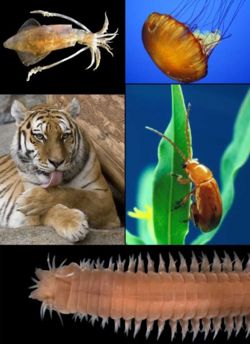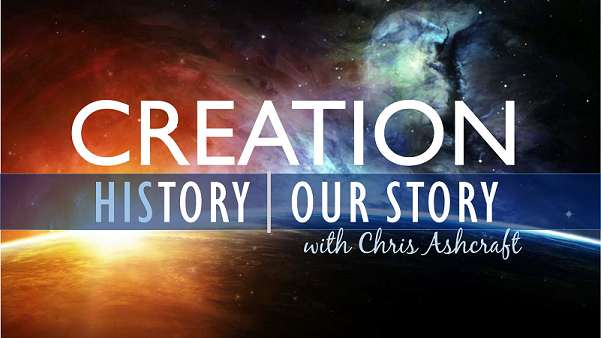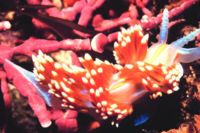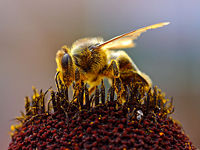The Animals of Creation
| Student files |
 Animals are
any of the species of organisms that
are assigned to the taxonomic Kingdom
Animalia, which contains groups broadly categorized as invertebrates and vertebrates.
The latter contains the familiar types such as mammals, amphibians, birds, fish,
and reptiles;
these are the ones which include most domestic pets such as
the ordinary house cat.
The former, however, consists of those with or without an
exoskeleton like the insects, crustaceans, jellyfish, worms,
etc.
Animals are
any of the species of organisms that
are assigned to the taxonomic Kingdom
Animalia, which contains groups broadly categorized as invertebrates and vertebrates.
The latter contains the familiar types such as mammals, amphibians, birds, fish,
and reptiles;
these are the ones which include most domestic pets such as
the ordinary house cat.
The former, however, consists of those with or without an
exoskeleton like the insects, crustaceans, jellyfish, worms,
etc.
All animals are heterotrophic (eat other organisms), multicellular (made of many cells), and eukaryotes (have cells with a nucleus, organelles, etc.). These are the principal characteristics that distinguish the animals from the other major kingdoms on Earth (plants, fungi, protists, or bacteria). The kingdom Animalia is a very diverse group anatomically, reproductively, and ecologically, and contains millions of extinct and extant species.
Contents
[hide]Origin of Animals
The origin of organisms, such as the animals, is a central point of contention between the creation and evolution camps. Creationists believe that the many lifeforms on Earth are the result of an act of divine creation, whereas evolutionists hold to a naturalistic view of biological evolution and believe that all organisms share a common ancestry.
Creation
- Main Article: Creation
The Bible states in the book of Genesis that animals were created on 2 separate days. Aquatic and flying animals were created on the fifth day, whereas the land animals were created on the sixth day. This order of events is in stark contrast to the evolutionary timeline, which states that birds and whales evolved after reptiles and mammals respectively.
Day 5 - God created the sea creatures and birds[edit]
And God said, "Let the water teem with living creatures, and let birds fly above the earth across the expanse of the sky." 21 So God created the great creatures of the sea and every living and moving thing with which the water teems, according to their kinds, and every winged bird according to its kind. And God saw that it was good. 22 God blessed them and said, "Be fruitful and increase in number and fill the water in the seas, and let the birds increase on the earth." 23 And there was evening, and there was morning—the fifth day. Genesis 1:20-23
Day 6 - God created the land animals and man[edit]
And God said, "Let the land produce living creatures according to their kinds: livestock, creatures that move along the ground, and wild animals, each according to its kind." And it was so. 25 God made the wild animals according to their kinds, the livestock according to their kinds, and all the creatures that move along the ground according to their kinds. And God saw that it was good. 26 Then God said, "Let us make man in our image, in our likeness, and let them rule over the fish of the sea and the birds of the air, over the livestock, over all the earth, and over all the creatures that move along the ground." 27 So God created man in his own image, in the image of God he created him; male and female he created them. Genesis 1:24-27
Evolution
- Main Article: Biological evolution
The theory of evolution proposes that biological evolution acting over long periods of time has given rise to all organisms on Earth from a single ancestral organism. It is believed that land animals evolved from ancient amphibians, which gave rise to reptiles and mammals. Some of these in turn developed into birds and aquatic mammals.
This principle, known as common descent, is the cornerstone of evolution and is taught as a fact today in government schools. However, an examination of this theory will find it wanting for physical evidence. Phylogenetic trees, such as the one at right, demonstrate the absence of transitional forms, which should be found labeled at each of the branchings where the various kinds of organisms are thought to have diverged from one another.
Anatomy
The Kingdom Animalia is a diverse group anatomically and includes varieties that are either vertebrates or invertebrates. Body shapes of animals can be either bilateral or radial, although the latter may only be found in marine invertebrates.
Vertebrates
- Main Article: Vertebrata
The vertebrates are a subphylum of Animalia. As their name implies, they are distinguished by the presence of a vertebral column or backbone. The vertebrates are divided into a number of classes based largely on certain anatomical differences.
- Mammals - Mammals typically have fur or hair. The name mammals comes from the possession of the mammary glands used to feed infants.
- Reptiles - Reptiles tend to have scales. The organization of a reptile's internal organs reflects the long, narrow body structure typical of most vertebrates.
- Birds - Birds have feathers instead of hair, fur, or scales. Birds are also bipedal, or walk on 2 legs, and most use their two wings to fly. The body temperature of a bird is normally several degrees higher than those of mammals.
- Fish- Fish have scales, and live in either fresh or salt water environments.
Invertebrates
Invertebrates are characterized by the absence of a vertebral column that provides structural support in vertebrates. Many invertebrates instead secrete an exoskeleton, such the arthropods, corals, or shellfish. Many marine invertebrates rely mostly on the turgor pressure afforded by their fluid-filled bodies to keep them upright.
Most invertebrates are found with the linear body structure known as bilateral symmetry, and a distinct head region (cephalization). However, some invertebrates have radial symmetry, such as the echinoderms (starfish), and cnidarians (coral, anemone). In contrast, others such as the sponges have neither symmetry, nor a head.
Ecology
Habitats
Animals live virtually any place that we look on Earth. From the tops of mountains to the bottom of the oceans, we find animals. They have adapted to a wide variety of climates and conditions. Some animals tolerate extreme heat. Others are found in extreme cold, such as the arctic circle. Worms have even been found living in glacial ice.[1]
Niches
In addition to anatomical features, animals are classified by what they eat. There are 4 general categories for heterotrophic organisms: herbivores, carnivores, scavengers, and parasitic.
- Herbivores eat plants. Many herbivores obtain energy from plant matter (cellulose) by using the decomposing capabilities of bacteria or fungi (i.e. ruminants). Some animals have developed symbiotic relationships with plants, such as those that pollinate in exchange for nectar or pollen.
- Carnivores eat other animals. Most carnivores also act as scavengers.
- Scavengers eat a wide variety of organic debris. Many live off dead animals; others filter-feed by consuming particulates or microorganisms they gather from the water. The earthworm actually consumes dirt.
- Parasites live on or in another organism.
According to the Genesis account, all animals were originally created as herbivores, and it is presumed that carnivorous, scavenger, and parasitic behaviors developed due to necessity after God cursed the creation due to Adam and Eve's sin.
Then God said, "I give you every seed-bearing plant on the face of the whole earth and every tree that has fruit with seed in it. They will be yours for food. And to all the beasts of the earth and all the birds of the air and all the creatures that move on the ground—everything that has the breath of life in it—I give every green plant for food." And it was so. Genesis 1:29-30
In Deuteronomy 14:3-20 animals are defined as clean and unclean as part of the mosaic dietary law. In general, the clean animals are all obligate herbivores (eating only plants), whereas the unclean animals are either carnivores or scavengers. This may be due to the fact that carnivores and scavengers frequently carry pathogens such as parasites, which are not found in herbivores. Some scavengers also accumulate toxins to levels that are dangerous to humans.
Motility
Animals come with a wide-range of capabilities for movement. Some can travel hundreds of miles in a day, whereas others remain planted to a substrate throughout their life. Most animals are mobile to some extent, and a great many of the sessile varieties have a free-swimming larval stage.
Reproduction
Almost all animals undergo some sort of sexual reproduction. All adults are diploids, this is saying that the cells of adults contain two copies of the genetic material. The development of most animals is characterized by distinctive stages, including a zygote, a blastula, a gastrula, and the blastopore. A lot of animals also produce asexually. This may take place through parthenogenesis, where fertile eggs are produced without mating, or in some cases through fragmentation. All the species in the Kingdom Animalia develop at different rates.
Animals
Reference
- ↑ North Cascade Glacier Ice Worm Research Nichols College, 2007. Accessed August 27, 2008.
The Animals of Creation - Amazing Designs
| Student files | Teacher files |





